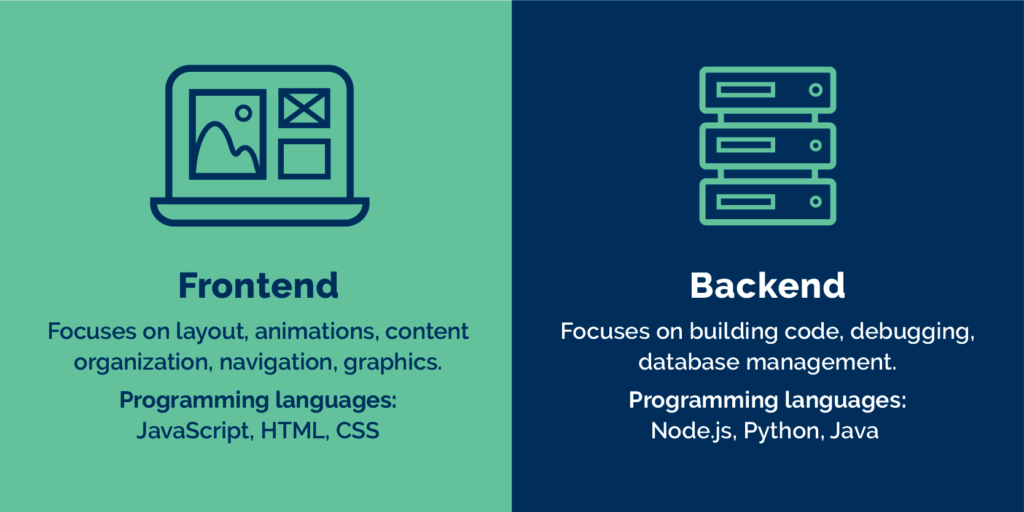Web Development Woes: Resolving Common Front-end and Back-end Challenges

Web development projects inevitably encounter obstacles, with front-end and back-end issues posing significant challenges. Front-end woes manifest as user-facing glitches, affecting website aesthetics and navigation. These include design inconsistencies, browser compatibility issues, and slow loading times. On the back-end, problems arise within the server architecture, database, or application logic, leading to errors or server outages.

Tackling Front-end Hiccups

Cross-browser compatibility remains a thorn in the side of front-end developers. Ensuring seamless website rendering across diverse browsers requires meticulous testing and coding adjustments. Additionally, optimizing website speed is paramount, as users are intolerant of slow page loading. Employing techniques such as image compression, minification, and caching can mitigate these issues.
Conquering Back-end Demons
Database management can be fraught with pitfalls, ranging from data integrity breaches to performance bottlenecks. Constant vigilance is required to prevent data corruption and ensure optimal database queries. Server-side code must also be robust, handling unexpected inputs and ensuring security against malicious attacks. Error handling and logging are crucial for troubleshooting and maintaining service availability.
Collaborative Resolutions
Resolving web development issues demands collaboration between front-end and back-end teams. Front-end developers must provide precise error descriptions, while back-end engineers must pinpoint the underlying server-side cause. Frequent communication and a shared understanding of the project’s architecture facilitate effective problem-solving.
Preventative Measures
Adopting best practices can preempt many common web development issues. Using a reliable framework, following coding conventions, and adhering to version control disciplines promotes code quality. Unit testing and continuous integration pipelines help detect and rectify errors early on. Regular monitoring and performance testing ensure ongoing website stability and responsiveness.
By understanding the nature of web development challenges and implementing proactive strategies, developers can mitigate potential roadblocks. Collaborative troubleshooting and adherence to best practices empower web development teams to build robust and reliable web applications.## Web Development Woes: Solving Common Front-end And Back-end Issues
Executive Summary
This comprehensive analysis provides practical solutions to persistent front-end and back-end development challenges. Whether you’re an experienced developer or just starting out, this guide will help you troubleshoot and resolve common issues, ensuring optimal website functionality and a seamless user experience.
Introduction
The complexities of website development often present challenges that can hinder the overall functionality and user experience. These issues can stem from the interplay between front-end and back-end technologies, requiring a comprehensive understanding and tailored solutions to resolve. This article aims to provide a deep dive into the common issues that developers face, along with actionable steps to address them.
FAQ
1. What are the most common front-end development issues?
- Broken links or images
- Unresponsive design on different devices
- Slow loading times
- Accessibility concerns
- Browser compatibility issues
2. What are the most common back-end development issues?
- Database connectivity problems
- Slow queries or performance bottlenecks
- Security vulnerabilities
- Integration with third-party services
- Data validation and handling errors
3. What should I do if I encounter a development issue?
- Identify the issue clearly: Determine if the problem lies in the front-end or back-end, and gather relevant logs or error messages.
- Research the issue: Use online forums, documentation, or search engines to find known solutions or best practices.
- Test potential solutions: Implement suggested solutions cautiously, testing them thoroughly to avoid further complications.
- Monitor and troubleshoot: After implementing solutions, continuously monitor the website to ensure they are working effectively and addressing the underlying issue.
Top 5 Subtopics
Front-end Performance Optimization
- Caching and minimizing: Leveraging caching mechanisms and optimizing image and code size can reduce load times.
- Browser optimization: Using modern browser APIs and optimizing CSS and JavaScript can improve browser rendering.
- Mobile responsiveness: Ensuring the website adapts seamlessly to all devices enhances user experience and accessibility.
- CDN (Content Delivery Network): Distributing content through a CDN can speed up delivery and reduce latency.
- Code profiling: Analyzing code performance and identifying bottlenecks can help identify areas for improvement.
Back-end Security Enhancements
- Data encryption and secure storage: Implementing encryption protocols and secure storage practices protects sensitive user data.
- Input validation and sanitization: Validating and sanitizing user input prevents malicious code or SQL injection attacks.
- Firewall and intrusion detection: Implementing firewalls and intrusion detection systems monitors and blocks unauthorized attempts.
- Regular software updates: Updating software and dependencies ensures the latest security patches are applied.
- Intrusion testing: Perform regular security tests to identify vulnerabilities and mitigate risks.
Database Management and Optimization
- Choosing the right database: Selecting an appropriate database type based on the project’s needs ensures optimal performance.
- Query optimization: Optimizing queries by using indexing, efficient joins, and caching strategies can improve database response times.
- Data structure and normalization: Designing an effective data structure and implementing data normalization can enhance data integrity and performance.
- Database backups and recovery: Regularly backing up the database and establishing a recovery plan ensures data protection.
- Monitoring and performance analysis: Monitoring database performance and analyzing usage patterns helps identify bottlenecks and fine-tune configurations.
Third-Party API Integration
- API selection and evaluation: Choosing reliable and reputable APIs and carefully evaluating their features and documentation.
- Data mapping and conversion: Mapping data formats between the website and the API ensures seamless integration.
- Authentication and authorization: Implementing appropriate authentication and authorization mechanisms to control API access.
- Caching and rate limiting: Caching API responses and implementing rate limiting strategies can optimize performance and prevent overloading.
- Error handling and fallback scenarios: Planning for potential API failures and implementing fallback mechanisms ensures accessibility.
Responsive and Accessible Web Design
- Cross-browser compatibility: Ensuring the website displays and functions consistently across different browsers.
- Responsive design techniques: Using CSS media queries and flexible layouts to adapt the website to various screen sizes.
- Keyboard accessibility: Ensuring accessibility for users with disabilities by providing keyboard navigation and alternative text for images.
- Color contrast and typography: Choosing appropriate color contrasts and typography to enhance readability and accessibility.
- Content optimization: Using clear and concise language, structuring content effectively, and adhering to accessibility guidelines.
Conclusion
By understanding and addressing these common front-end and back-end development issues, developers can create websites that are both reliable and engaging. This article provides a comprehensive approach to resolving challenges, ensuring optimal user experience, and maintaining a robust online presence. Implementing the solutions outlined in this guide will empower developers to overcome development woes and deliver exceptional web applications that meet the demands of the modern digital landscape.
Keyword Tags
- Front-end Development
- Back-end Development
- Performance Optimization
- Security Enhancements
- Database Management



